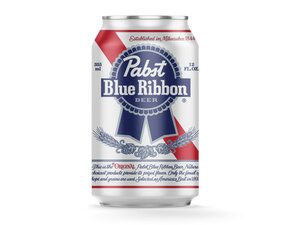crwdns2944766:0crwdne2944766:0
crwdns2918718:0crwdne2918718:0crwdns2935091:0crwdnd2935091:0crwdne2935091:0
Background Information
Pabst Blue Ribbon, commonly abbreviated as PBR, is an American lager beer produced by the Pabst Brewing Company, founded in Milwaukee, Wisconsin, in 1844. Initially named Best Select and later Pabst Select, the current name originated from the blue ribbons that adorned the bottles between 1882 and 1916.
Historic Significance
Pabst Family and Best Brewing Company
In 1848, twelve-year-old Fredric Pabst was brought to the United States by his parents, Gottieb and Frederika Pabst. They settled in Chicago, where Fredric found work as a cabin boy on a Lake Michigan steamer. In 1857, he earned his pilot’s license and became a captain. During this time, he met Phillip Best, the owner of the Best Brewing Company. In 1862, Pabst married Phillip’s daughter. In December 1863, his ship ran aground while attempting to bring the craft into the Milwaukee harbor, which led to his employment as a brewer at his father-in-law’s brewery.
After Philip Best retired in 1867, Pabst collaborated with Emil Schandein, the then vice-president of Best Brewery, to transform Best Brewery into one of the largest beer producers in the United States. The Great Chicago Fire of 1871, which destroyed nineteen Chicago breweries, played a pivotal role in elevating Milwaukee to the status of the leading beer-producing city in the United States. After Schandein's death in 1889, Pabst was appointed president of Best Brewery, and officially changed the letterhead to Pabst in 1890.
Pabst Blue Ribbon
The Pabst company officially renamed its flagship beer to Pabst Blue Ribbon after its triumph as “America’s Best” at the 1893 World’s Columbian Exposition. However, it remains uncertain whether the brand actually won an award in 1893. Some accounts indicate that the fair declined to bestow any such prizes. One account suggests that the fair’s executive committee only awarded bronze medals, acknowledging “some independent and essential excellence in the article displayed,” rather than solely to signify the relative merits of competing exhibits.
Regardless, Pabst received widespread acclaim and numerous other awards at various fairs. To the extent that between 1882 and 1916, the bottles of Pabst were adorned with blue silk ribbons tied around the bottle.
The Greatest Beer Run Ever
In 1967, during the Vietnam conflict’s peak and amidst growing divisions and dissatisfaction among Americans regarding the war’s handling, a 26-year-old New Yorker named John “Chickie” Donohue embarked on a personal mission to Vietnam. His purpose was to deliver a beer to his friends and convey their support from their home neighborhood of Inwood in Upper Manhattan.
Carrying a duffel bag filled with Pabst Blue Ribbon, Donohue embarked on a journey by ship into a war zone. Over the course of four months, he successfully located his childhood friends and fellow neighborhood men scattered across combat zones. Together, they shared a cold drink and a reminder that they were not forgotten. This simple journey to deliver Pabst Blue Ribbon is now regarded as The Greatest Beer Run Ever.
The Greatest Beer Run Ever
Technical Specifications
General Information
- Brewery Origin: Best Brewing Company (1844), later Pabst Brewing Company (1893)
- Style: American lager
- Origin: Milwaukee, Wisconsin, United States
- Serving Size: 12 fl oz can/bottle — or a 24 oz “tallboy”
Ingredients
- Sugar Source: Rice & Corn
- Starch Source: 6-row Barley
- Preservation Source: Hops
- Yeast: Yes
- Water: Yes
Alcohol By Volume (ABV)
- ABV (Alcohol by Volume): 4.7%
- Proof: 9.4%
Taste Profile
- International Bitterness Units (IBU): 10
- Description: Description: Pabst Blue Ribbon (PBR) is described as having a smooth, crisp, and easy-drinking taste profile, often featuring light multi-grain, barley, and earthy notes with a slightly sweet finish.
Nutrition Facts (per 12 oz serving)
- Calories: 153
- Total Fat: 0 g
- Carbohydrates: 13 g
- Protein: 1.6 g
- Sugars: 0 g
- ABV: 4.7%


